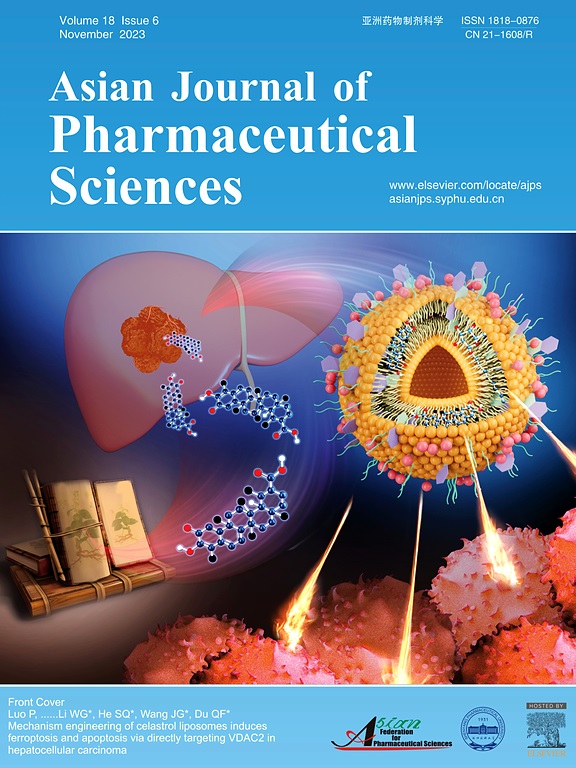Tumor-specific liquid metal nitric oxide nanogenerator for enhanced breast cancer therapy
IF 10.7
1区 医学
Q1 PHARMACOLOGY & PHARMACY
引用次数: 0
Abstract
Nitric oxide (NO) modulates several cancer-related physiological processes and has advanced the development of green methods for cancer treatment and integrated platforms for combination or synergistic therapies. Although a nanoengineering strategy has been proposed to overcome deficiencies of NO gas or small NO donor molecules, such as short half-life, lipophilicity, non-selectivity, and poor stability, it remains challenging to prepare NO nanomedicines with simple composition, multiple functions and enhanced therapeutic efficacy. Herein, we build a liquid metal nanodroplet (LMND)-based NO nanogenerator (LMND@HSG) that is stabilized by a bioreducible guanylated hyperbranched poly(amido amine) (HSG) ligand. Mechanically, the tumor microenvironment specifically triggers a cascade process of glutathione elimination, reactive oxygen species (ROS) generation, and NO release. According to actual demand, the ROS and NO concentrations could be readily controlled by tuning the LMND and HSG feed amounts. Along with the intrinsic anticancer property of LMND (ROS-mediated apoptosis and anti-angiogenesis), LMND@HSG administration could further enhance tumor growth suppression compared with LMND and HSG alone. From this study, leveraging LMND for NO gas therapy provides more possibilities for the prospect of LMND-based anticancer nanomedicines.

肿瘤特异性液态金属一氧化氮纳米发生器增强乳腺癌治疗
一氧化氮(NO)调节几种与癌症相关的生理过程,并推动了绿色癌症治疗方法的发展和联合或协同治疗的综合平台。虽然已经提出了一种纳米工程策略来克服NO气体或NO小供体分子半衰期短、亲脂性、非选择性、稳定性差等缺点,但制备成分简单、功能多样、治疗效果增强的NO纳米药物仍然是一个挑战。在此,我们构建了一个基于液态金属纳米液滴(LMND)的NO纳米发生器(LMND@HSG),该发生器由生物可还原的鸟酰化超支化聚氨基胺(HSG)配体稳定。机械地,肿瘤微环境特异性地触发谷胱甘肽消除、活性氧(ROS)生成和NO释放的级联过程。根据实际需要,可以通过调整LMND和HSG的投喂量来控制ROS和NO的浓度。随着LMND固有的抗癌特性(ros介导的细胞凋亡和抗血管生成),与单独使用LMND和HSG相比,LMND@HSG给药可以进一步增强肿瘤生长抑制。从本研究来看,利用LMND进行NO气体治疗为基于LMND的抗癌纳米药物的前景提供了更多的可能性。
本文章由计算机程序翻译,如有差异,请以英文原文为准。
求助全文
约1分钟内获得全文
求助全文
来源期刊

Asian Journal of Pharmaceutical Sciences
Pharmacology, Toxicology and Pharmaceutics-Pharmaceutical Science
CiteScore
18.30
自引率
2.90%
发文量
11
审稿时长
14 days
期刊介绍:
The Asian Journal of Pharmaceutical Sciences (AJPS) serves as the official journal of the Asian Federation for Pharmaceutical Sciences (AFPS). Recognized by the Science Citation Index Expanded (SCIE), AJPS offers a platform for the reporting of advancements, production methodologies, technologies, initiatives, and the practical application of scientific knowledge in the field of pharmaceutics. The journal covers a wide range of topics including but not limited to controlled drug release systems, drug targeting, physical pharmacy, pharmacodynamics, pharmacokinetics, pharmacogenomics, biopharmaceutics, drug and prodrug design, pharmaceutical analysis, drug stability, quality control, pharmaceutical engineering, and material sciences.
 求助内容:
求助内容: 应助结果提醒方式:
应助结果提醒方式:


